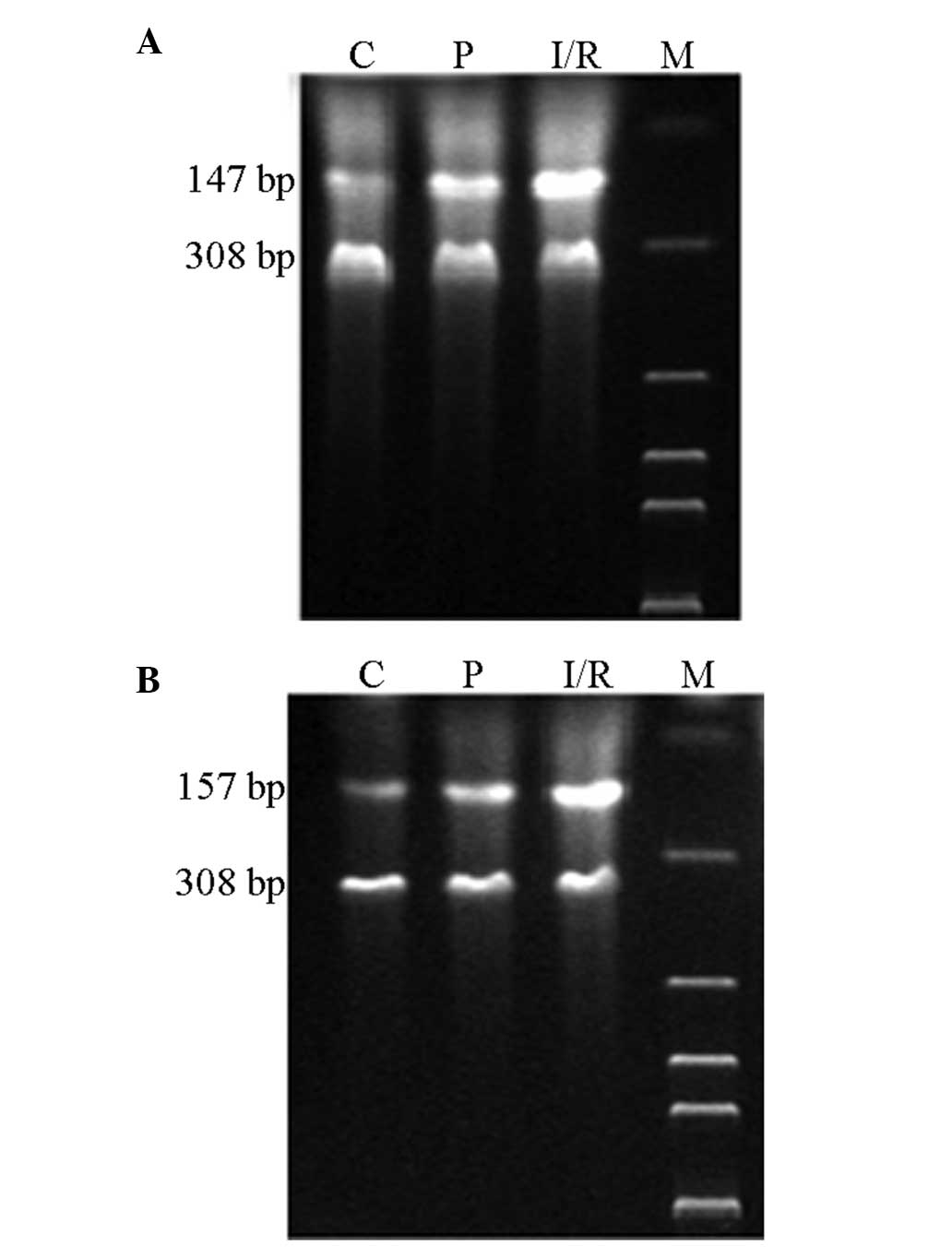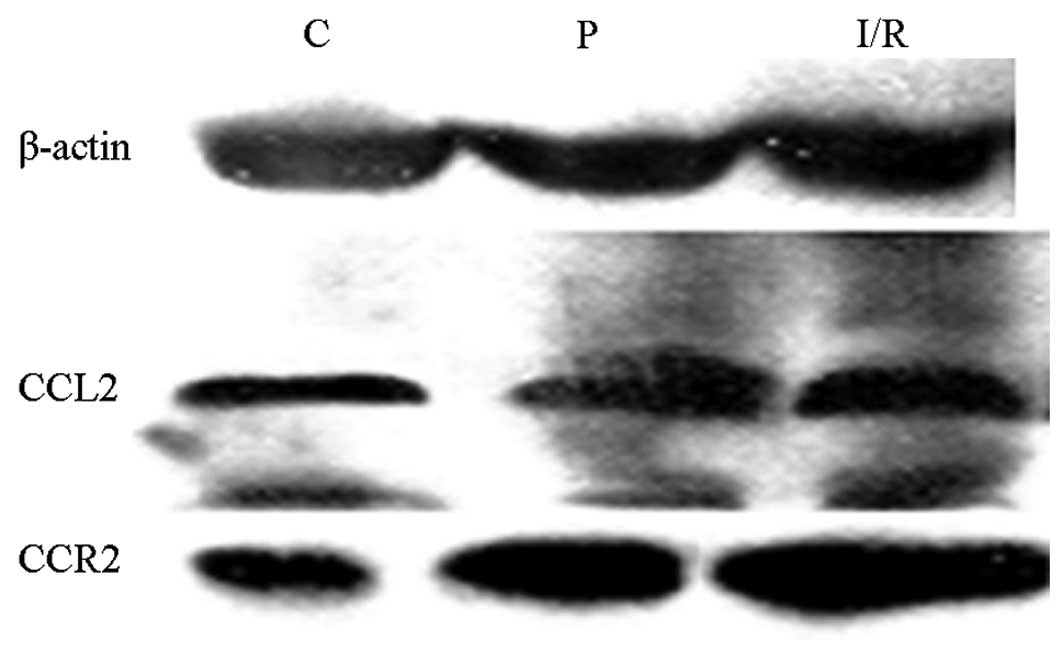|
1
|
Silbernagel G, Machann J, Häring HU,
Fritsche A and Peter A: Plasminogen activator inhibitor-1, monocyte
chemoattractant protein-1, e-selectin and C-reactive protein levels
in response to 4-week very-high-fructose or -glucose diets. Eur J
Clin Nutr. 68:97–100. 2014. View Article : Google Scholar
|
|
2
|
Hazalin NA, Lim SM, Cole AL, Majeed AB and
Ramasamy K: Apoptosis induced by desmethyl-lasiodiplodin is
associated with upregulation of apoptotic genes and downregulation
of monocyte chemotactic protein-3. Anticancer Drugs. 24:852–861.
2013. View Article : Google Scholar : PubMed/NCBI
|
|
3
|
Shimizu S, Nakashima H, Karube K, Ohshima
K and Egashira K: Monocyte chemoattractant protein-1 activates a
regional Th1 immunoresponse in nephritis of MRL/lpr mice. Clin Exp
Rheumatol. 23:239–242. 2005.PubMed/NCBI
|
|
4
|
Chaturvedi LS, Zhang P and Basson MD:
Effects of extracellular pressure and alcohol on the microglial
response to inflammatory stimulation. Am J Surg. 204:602–606. 2012.
View Article : Google Scholar : PubMed/NCBI
|
|
5
|
Volpe S, Cameroni E, Moepps B, et al: CCR2
acts as scavenger for CCL2 during monocyte chemotaxis. PLoS One.
7:e372082012. View Article : Google Scholar : PubMed/NCBI
|
|
6
|
Banisadr G, Gosselin RD, Mechighel P, et
al: Constitutive neuronal expression of CCR2 chemokine receptor and
its colocalization with neurotransmitters in normal rat brain:
functional effect of MCP-1/CCL2 on calcium mobilization in primary
cultured neurons. J Comp Neurol. 492:178–192. 2005. View Article : Google Scholar
|
|
7
|
Banisadr G, Gosselin RD, Mechighel P, et
al: Highly regionalized neuronal expression of monocyte
chemoattractant protein-1 (MCP-1/CCL2) in rat brain: evidence for
its colocalization with neurotransmitters and neuropeptides. J Comp
Neurol. 489:275–292. 2005. View Article : Google Scholar
|
|
8
|
Foresti ML, Arisi GM, Katki K, et al:
Chemokine CCL2 and its receptor CCR2 are increased in the
hippocampus following pilocarpine-induced status epilepticus. J
Neuroinflammation. 6:402009. View Article : Google Scholar : PubMed/NCBI
|
|
9
|
Harman F, Hasturk AE, Yaman M, et al:
Neuroprotective effects of propofol, thiopental, etomidate, and
midazolam in fetal rat brain in ischemia-reperfusion model. Childs
Nerv Syst. 28:1055–1062. 2012. View Article : Google Scholar : PubMed/NCBI
|
|
10
|
McIntosh MP and Rajewski RA: Comparative
canine pharmacokinetics-pharmacodynamics of fospropofol disodium
injection, propofol emulsion, and cyclodextrin-enabled propofol
solution following bolus parenteral administration. J Pharm Sci.
101:3547–3552. 2012. View Article : Google Scholar
|
|
11
|
Lee Y, Chung C and Oh YS: Effectiveness of
propofol pretreatment on the extent of deranged cerebral
mitochondrial oxidative enzyme system after incomplete forbrain
ischemia/reperfusion in rats. J Korean Med Sci. 15:627–630. 2000.
View Article : Google Scholar
|
|
12
|
Peters CE, Korcok J, Gelb AW and Wilson
JX: Anesthetic concentrations of propofol protect against oxidative
stress in primary astrocyte cultures: comparison with hypothermia.
Anesthesiology. 94:313–321. 2001. View Article : Google Scholar : PubMed/NCBI
|
|
13
|
Tsuchiya M, Asada A, Maeda K, et al:
Propofol versus midazolam regarding their antioxidant activities.
Am J Respir Crit Care Med. 163:26–31. 2001. View Article : Google Scholar : PubMed/NCBI
|
|
14
|
Buggy DJ, Nicol B, Rowbotham DJ and
Lambert DG: Effects of intravenous anesthetic agents on glutamate
release: a role for GABAA receptor-mediated inhibition.
Anesthesiology. 92:1067–1073. 2000. View Article : Google Scholar : PubMed/NCBI
|
|
15
|
Yu D, Jiang Y, Gao J, Liu B and Chen P:
Repeated exposure to propofol potentiates neuroapoptosis and
long-term behavioral deficits in neonatal rats. Neurosci Lett.
534:41–46. 2013. View Article : Google Scholar : PubMed/NCBI
|
|
16
|
Kobayashi M, Takeda Y, Taninishi H, et al:
Quantitative evaluation of the neuroprotective effects of
thiopental sodium, propofol, and halothane on brain ischemia in the
gerbil: effects of the anesthetics on ischemic depolarization and
extracellular glutamate concentration. J Neurosurg Anesthesiol.
19:171–178. 2007. View Article : Google Scholar
|
|
17
|
Cai J, Hu Y, Li W, et al: The
neuroprotective effect of propofol against brain ischemia mediated
by the glutamatergic signaling pathway in rats. Neurochem Res.
36:1724–1731. 2011. View Article : Google Scholar : PubMed/NCBI
|
|
18
|
Li J, Han B, Ma X and Qi S: The effects of
propofol on hippocampal caspase-3 and Bcl-2 expression following
forebrain ischemia-reperfusion in rats. Brain Res. 1356:11–23.
2010. View Article : Google Scholar : PubMed/NCBI
|
|
19
|
Ji K and Tsirka SE: Inflammation modulates
expression of laminin in the central nervous system following
ischemic injury. J Neuroinflammation. 9:1592012. View Article : Google Scholar : PubMed/NCBI
|
|
20
|
Murphy CA, Hoek RM, Wiekowski MT, Lira SA
and Sedgwick JD: Interactions between hemopoietically derived TNF
and central nervous system-resident glial chemokines underlie
initiation of autoimmune inflammation in the brain. J Immunol.
169:7054–7062. 2002. View Article : Google Scholar
|
|
21
|
Babcock AA, Kuziel WA, Rivest S and Owens
T: Chemokine expression by glial cells directs leukocytes to sites
of axonal injury in the CNS. J Neurosci. 23:7922–7930.
2003.PubMed/NCBI
|
|
22
|
Yao Y and Tsirka SE: The CCL2-CCR2 system
affects the progression and clearance of intracerebral hemorrhage.
Glia. 60:908–918. 2012. View Article : Google Scholar : PubMed/NCBI
|
|
23
|
Andres RH, Choi R, Pendharkar AV, Gaeta X,
Wang N, et al: The CCR2/CCL2 interaction mediates the
transendothelial recruitment of intravascularly delivered neural
stem cells to the ischemic brain. Stroke. 42:2923–2931. 2011.
View Article : Google Scholar : PubMed/NCBI
|
|
24
|
Semple BD, Kossmann T and
Morganti-Kossmann MC: Role of chemokines in CNS health and
pathology: a focus on the CCL2/CCR2 and CXCL8/CXCR2 networks. J
Cereb Blood Flow Metab. 30:459–473. 2010. View Article : Google Scholar : PubMed/NCBI
|











